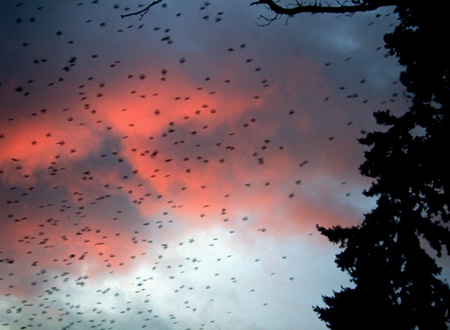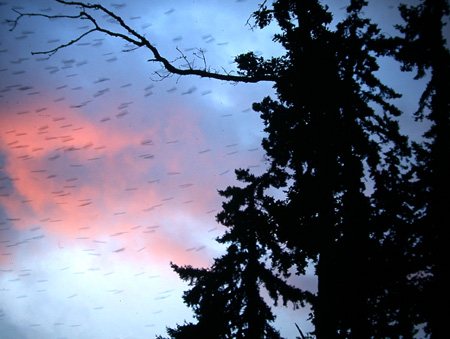
......
To be a Semantic Web, it must be mechanical, and therefore precise, mathematical, and ultimately unambiguous. But to be a Semantic Web, it must also encapsulate meaning, context, and embrace ambiguity. Ignore the discontinuities, embrace the discontinuities.

What does this all mean? If a resource is defined to be anything, including something abstract then how can it have an identifier on the web, in the form of a URI? But if a resource within the context of the Semantic Web is defined to be something on the web, then how can it not have a URI? If we limit resources to things on the web, how can we identify things as disparate as a person, a galaxy, and an abstraction such as a metaphor in a poem? And how can one global set of URIs work for all items, at all granularities?
.....
I personally care about this debate because I want to make sure my metaphor, my syllogism, and my analogy are represented effectively or my own Turing Test for the Semantic Web will never come about. I don't want these abstract concepts to be discarded because they can't be mathmatically defined.
"What we need to understand may only be expressible in a language that we do not know."
Anthony Judge
That would be a pity.

In the title I introduced FOAF, and you might be wondering where this simple RDF-based vocabulary fits into this grand debate. I could wish that the membership of the W3C wasn't so averse to webloggers -- our seeming arrogance and assumptions of our importance on the web, and our messiness -- because the issues the TAG members are discussing are related to what's happening with FOAF among the weblogging community. It is a microcosm of the Semantic Web, with its rich possibilities and its many ambiguities and misunderstandings.
......
Not one FOAF file I have seen uses a URI to represent the person. They either don't use anything, or they use what is known as a blank node identifier, which is only relevant to the file. However, the lack of a URI hasn't impacted adversely in FOAF because each person identified within the context of FOAF is done so through two alternative keys: the mbox_sha1sum, which is the hashed representation of my email address; and/or the URL (URI) of my FOAF file -- http://burningbird.net/foaf.rdf.
Neither key is officially a URI of my representation within the context of either the existing or the semantic web. We have simply worked around the debate and issue of how can one identify a representation of ourselves on the Net by not using an identifier. We could use an analogy of parents arguing about proper diet, while we hungry children raid the fridge and eat all the pie. We could, but there's no URI for analogies, either, and therefore must not have a proper place in a proper discussion of the proper Semantic Web.
Then there's the issue of what's being identified -- is the person the resource? Or is the FOAF information the resource, and I'm defined by many such? Additionally, FOAF files also denote other resources -- or what we're assuming are resources because they are, after all, defined within the Resource Description Framework -- and they're parameteritized, if that's the right word, by using the RDF property 'knows'. However, we don't have a good understand of what it is we're defining with 'knows'. Is it denoting a relationship? Or is it nothing more than an acknowledgement that I literally know who Simon St. Laurent is? Is Simon a friend, because he's in a FOAF file? If so then, what were to happen if I wasn't in Simon's FOAF file?
If I were to remove Simon from my FOAF file, an I disavowing the friendship? Or am I 'pretending' that I don't 'know' Simon? With FOAF, we not only assert truth, we assert a lie, because I know Simon, and him not being in my FOAF file, or not, doesn't change this. If I don't list him, am I lying by omission? What does it mean to be in one of these files? What does it mean when you are not?
Will you 'feel' it, when you're not?
The fact is that FOAF is being used as a representation of something, we're making assertions about something but we're not sure of what. Whatever it is, though, it's loaded with connotations.
Within FOAF we're representing information about ourselves, but it's not us -- too flat, too two-dimensional to be a representation of us. Additionally, we're representing relationships with other people, but we're each bringing our own interpretations of these relationships along for the ride. In other words, we're making assertions of relationships, and attaching social context to them.
In the RDF Concepts working draft, there was a section that discussed the social context of assertions. It is the one and only section of all the RDF documents that brings up the issue of social context about RDF statements. The only one. And of course, it is this section that the Semantic Web Architecture recommended be struck.
Why the cut? From the meeting minutes where the recommendation arose, it would seem to come back to our old debate of URI and context. There was too much confusion about what was meant by 'identify', by URI, by resource. As Dan Brickley said in IRC notes:
21:10:54 [bwmscribe]
authoritive definition of URI's: i.e. who gets to say what a URI denotes
21:12:48 [danbri]
something like "RDF graphs have propositional content. Their meaning is fixed by a bunch of hairy stuff only partly understood and documented (eg. implicit theory of reference associated with URIs). Minor health warning. The End."
But that doesn't stop the confusion -- ignoring the concept of 'resource', postponing the issue of identity, and ignoring social context because it's too hard to define, won't prevent problems when people act to fill the void that's left.
........

Consider FOAF files again: Marc Canter and Eric Sigler are working on this thing that Marc is calling a "PeopleAggregator". From bits and pieces I've picked up at their weblogs, in emails, and in comments elsewhere, this application will be able to create and consume and maintain FOAF files as well as networks of interlinked people who 'know' each other, as defined in these files. More, if someone within the network designates you a 'friend' in their FOAF file, the PeopleAggregator sends you an email asking for some form of confirmation.
(Again, this is based on casual discussion in comments and may be incorrect in whole or part.)
Rather than the network of friends being maintained behind walls ala Friendster, it's out in the open with decentralized FOAF files that anyone can read. Now, what will become the social context behind the relationships denoted as resources withing these FOAF files? And what can be the social consequences of same?
Personally, I expect the first 'Technorati of FOAF popularity" before the year is out. I wonder, what crown will we give to the man and woman voted most popular? Prom king and queen? I also wonder, how soon will we get emails saying, "Please remove me from your FOAF file -- you don't really know me" How soon will we get emails saying, "Why am I not in your FOAF file"?
If you doubt this, then look no further for proof then the plain, ordinary, unsemantic hypertext links that form our blogrolls. Remember public delinking, and how in the past this has been used as a measure of censorship, and as a form of punishment and control? I've been delinked, publicly and privately, from friend and foe, and believe me when I say there is more to this than a simple hypertext link, and the removal thereof.
Remember also the discussions of the power that these links provide within this communication medium because -- as Clay Shirky has demonstrated with his power laws -- those with a disportionate share of weblogging links also have a disportionate share of attention, and even respect?
Power and pain, reward and punishment, all encapsulated in a simple hypertext link, in a simple blogroll -- what can happen within the socially explosive context of FOAF?
Both Tims might say that the FOAF example isn't relevant -- weblogging is its own problem, and isn't really representative of the web as a whole. After all, there's billions of pages on the web, and only about a half million webloggers, if that.
But webloggers are becoming the Semantic Web lab rats -- through our curiosity and our interest, we're the first to test these Semantic Web tools outside of labs and universities. We're the ones that propagate the data and the technologies. When faced with confusion, we'll wing it. We did so with RSS 1.0, we're doing so with Pie/Echo/Atom and now we're continuing the trend with FOAF.
FOAF is becoming the bastard child that grew from the seeds that fell between the cracks of W3C debates, or were discarded with all the other messy 'touchy feely' stuff, such as social context surrounding URIs. It's the wolf child tempered in the pack, surviving on an existence of "keep what works, throw out the rest". One can't blame it, then, if it, and we, don't behave properly when invited to the Semantic Web tea.
And the more I look at these photos the more I think some are upside down. I can't really tell for sure, the slides aren't properly marked -- but the images are pretty and my representing them upside down on the web doesn't stop the birds from flying.
 Posted by Shelley at August 5, 2003 07:54 PM
Posted by Shelley at August 5, 2003 07:54 PM 